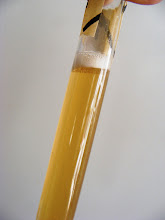I am happy to report that the nano "Yorkshire Square" performed fabulously for it's inaugural fermentation. I decided to use WLP 0023 "Thames Valley" yeast to inoculate this fermenter with. Being an open fermentation I was looking for a true "top cropping" yeast to provide a good biological cover to the fermenting wort. I also wanted a yeast with lots of character which I thought would be fitting for beer being produced in this fermenter.
Boy, I was not disappointed. This yeast took off quick! The once the krausen started rising I could almost see it rising before my eyes. Certainly there were noticible differences as I checked it every hour. I thought the most interesting point was fairly early on as the krausen really began to take off in what I called the merangue phase. It really looked like a merangue on a pie! It was right around this phase when there was enough anaerobic metabolism going on that the carbon dioxide was able to snuff out a flame.
The fermenter holds 6.5 gallons, apparently I whould have built it bigger (actually that was as big as my materials would allow). Five gallons of wort went into the fermenter and the krausen rose right up to the top and even overflowed a bit!
I've done a lot of fermentations in my house but I've never done one that was quite odiferous as this one. Almost as soon as that fermenation started it was the first smell you noticed when you entered the house. I think being open made a huge difference in terms of the amount of gas and aromas wafting out of the fermenter. I'm really curious to see if there is any noticeable impact on the flavor and aroma of the final product versus a carboy fermented version. We did do a group brew so 20 gallons of wort were produced for 4 different fermentations. Unfortunately I didn't think to have anyone else use the WLP 0023 yeast so we could have a comparison of fermenter effects.
I did have to rack the beer out of the fermenter before it completed it's primary fermentation. The big aroma and foaming over krausen aren't big features people are looking for when you are trying to sell your house and have an open house. It was definitely most of the way through the primary and seemed to finish out just fine in the carboy. Next time I hope to be able to let this ferment out all the way in the square. Actually I'd really like to try doing a mild and send it either straight to the bottle or cask to be drank within just a few weeks of fermentation.
This time around it was a big brown ale with an original gravity of 1.064 and a final gravity of 1.020. Going into the bottle it was tasting pretty good. Can't wait to taste this one once it's carbonated.
Saturday, April 3, 2010
Subscribe to:
Post Comments (Atom)









That is really cool! I do have a question or two for you though:
ReplyDelete1. How do you go about cleaning it out? Just wipe it up as best as you can?
2. Does the yeast stay in the crevices, so all you have to do next time is put the wort right in it?
As for the yeast smell in a open house, I saw a Good Eats episode where Alton Brown suggested baking yeasty stuff because men will associate it with beer.
Great Blog, Thanks!
Oops, sorry I thought I wrote back earlier...
ReplyDelete1.cleaning was a pain. I soaked and scrubbed with detergent before I used it for the first time. Then I soaked some more with star san (also a good leak test). After fermentation cleaning involved scooping, wiping, rinsing, and soaking with star san. Post fermentation was pretty disgusting unless you are into yeast!
2. My thought is that this vessel will likely become inoculated with microbes (preferably saccharomyces). I do not know if there would be enough in the crevices to start off a fermentation the way we typically want it too. I am in the process of moving so won't be able to brew again until at least July so I haven't had a chance to see what will happen in the second fermentation.
I think this could be the sort of vessel where you could potentially get established a house wild fermentation. I may potentially try that at some point.
It really is a fun fermenter but is more work than a traditional carboy or bucket. I keep driving by a landscaping place and seeing big giant slabs of slate....And thinking about how I could build a giant fermenter with those ;)
I bet!
ReplyDeleteI've heard of some breweries getting a "house" flavor from the critters that have made a home of their fermenters. I'm curious as to how it develops.
Thanks!